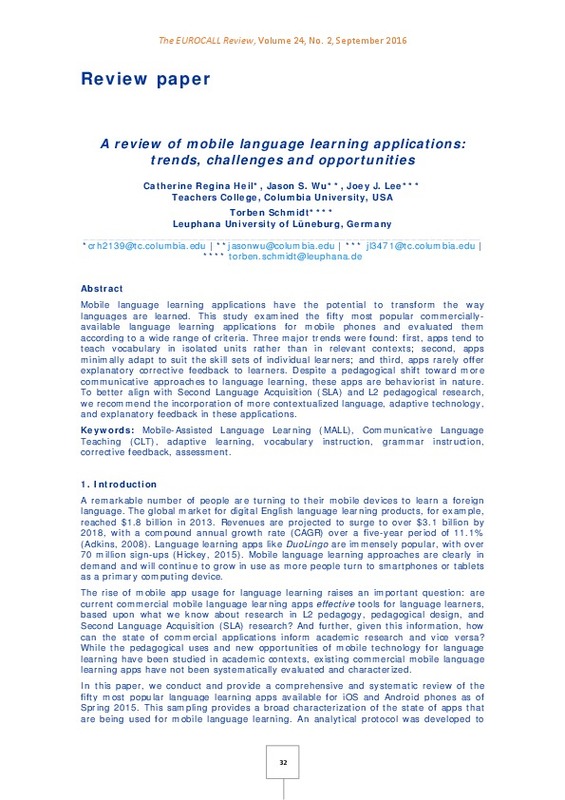Bachman, L. F., & Palmer, A. S. (1996). Language testing in practice: Designing and developing useful language tests. Oxford, UK: Oxford University Press.
BLYTH, C. (1997). A Constructivist Approach to Grammar: Teaching Teachers to Teach Aspect. The Modern Language Journal, 81(1), 50-66. doi:10.1111/j.1540-4781.1997.tb01626.x
Brown, H. D. (2007). Teaching by principles: An interactive approach to language pedagogy. White Plains, NY: Pearson Education.
[+]
Bachman, L. F., & Palmer, A. S. (1996). Language testing in practice: Designing and developing useful language tests. Oxford, UK: Oxford University Press.
BLYTH, C. (1997). A Constructivist Approach to Grammar: Teaching Teachers to Teach Aspect. The Modern Language Journal, 81(1), 50-66. doi:10.1111/j.1540-4781.1997.tb01626.x
Brown, H. D. (2007). Teaching by principles: An interactive approach to language pedagogy. White Plains, NY: Pearson Education.
Burston, J. (2014). Twenty years of MALL project implementation: A meta-analysis of learning outcomes. ReCALL, 27(1), 4-20. doi:10.1017/s0958344014000159
CANALE, M. (1980). THEORETICAL BASES OF COMMUNICATIVE APPROACHES TO SECOND LANGUAGE TEACHING AND TESTING. Applied Linguistics, 1(1), 1-47. doi:10.1093/applin/1.1.1
Carroll, S., & Swain, M. (1993). Explicit and Implicit Negative Feedback. Studies in Second Language Acquisition, 15(3), 357-386. doi:10.1017/s0272263100012158
Chen, C.-M., & Chung, C.-J. (2008). Personalized mobile English vocabulary learning system based on item response theory and learning memory cycle. Computers & Education, 51(2), 624-645. doi:10.1016/j.compedu.2007.06.011
Chinnery, G. (2006). Going to the MALL: Mobile Assisted. Language Learning, Language Learning & Technology, 10(1), 9-16.
Duman, G., Orhon, G., & Gedik, N. (2014). Research trends in mobile assisted language learning from 2000 to 2012. ReCALL, 27(2), 197-216. doi:10.1017/s0958344014000287
Ellis, R., Loewen, S., & Erlam, R. (2006). IMPLICIT AND EXPLICIT CORRECTIVE FEEDBACK AND THE ACQUISITION OF L2 GRAMMAR. Studies in Second Language Acquisition, 28(02). doi:10.1017/s0272263106060141
Gamper, J., & Knapp, J. (2002). A Review of Intelligent CALL Systems. Computer Assisted Language Learning, 15(4), 329-342. doi:10.1076/call.15.4.329.8270
Godwin-Jones, R. (2011). Emerging technologies: Mobile apps for language learning. Language Learning & Technology, 15(2), 2-11. Retrieved from http://llt.msu.edu/issues/june2011/emerging.pdf
Grohtjahn, R. (1987). On the methodological basis of introspective methods. In C. Faerch & G. Kasper (Eds.), Introspection in second language research (54-82). Clevedon, England: Multilingual Matters.
Hymes, D.H. (1972) "On Communicative Competence" In: J.B. Pride and J. Holmes (eds.) Sociolinguistics. Selected Readings. Harmondsworth: Penguin, pp. 269–293.
Kukulska-Hulme, A., & Bull, S. (2009). Theory-based Support for Mobile Language Learning: Noticing and Recording. International Journal of Interactive Mobile Technologies (iJIM), 3(2). doi:10.3991/ijim.v3i2.740
Kukulska-Hulme, A., & Shield, L. (2008). An overview of mobile assisted language learning: From content delivery to supported collaboration and interaction. ReCALL, 20(3), 271-289. doi:10.1017/s0958344008000335
Lee, Kwang-wu. "English teachers' barriers to the use of computer-assisted language learning." The Internet TESL Journal 6.12 (2000): 1-8.
Lyster, R., & Ranta, L. (1997). CORRECTIVE FEEDBACK AND LEARNER UPTAKE. Studies in Second Language Acquisition, 19(1), 37-66. doi:10.1017/s0272263197001034
Jurafsky, D., & Martin, J. H. (2008). Speech and language processing: An introduction to speech recognition. Computational Linguistics and Natural Language Processing. Prentice Hall.
Lee, J.F. & VanPatten, B. (2003). Making communicative language teaching happen (2nd ed.). New York: McGraw-Hill.
Moundridou, M., & Virvou, M. (2003). Analysis and design of a Web-based authoring tool generating intelligent tutoring systems. Computers & Education, 40(2), 157-181. doi:10.1016/s0360-1315(02)00119-7
Nah, K. C., White, P., & Sussex, R. (2008). The potential of using a mobile phone to access the Internet for learning EFL listening skills within a Korean context. ReCALL, 20(3), 331-347. doi:10.1017/s0958344008000633
Nation, P. (2015). Principles guiding vocabulary learning through extensive reading. Reading in a Foreign Language, 27(1), 136.
OXFORD, R. L. (1997). Cooperative Learning, Collaborative Learning, and Interaction: Three Communicative Strands in the Language Classroom. The Modern Language Journal, 81(4), 443-456. doi:10.1111/j.1540-4781.1997.tb05510.x
Pellegrino, J., Chudowski, N., and Glaser, R. (2001). Knowing what students know: the science and design of assessment. National Academies Press.
Purpura, J. E. (2004). Assessing Grammar. doi:10.1017/cbo9780511733086
Reinders, H., & Pegrum, M. (2016). Supporting Language Learning on the Move: An Evaluative Framework for Mobile Language Learning Resources. In B. Tomlinson (Ed.), Research and Materials Development for Language Learning (pp. 219-232). New York, NY: Routledge.
Sauvignon, S. J. (2002). Interpreting communicative language teaching: Contexts and concerns in teacher education. New Haven: Yale University.
Stockwell, G. (2008). Investigating learner preparedness for and usage patterns of mobile learning. ReCALL, 20(3), 253-270. doi:10.1017/s0958344008000232
Sweeney, P., & Moore, C. (2012). Mobile Apps for Learning Vocabulary. International Journal of Computer-Assisted Language Learning and Teaching, 2(4), 1-16. doi:10.4018/ijcallt.2012100101
Ur, P. (2013). The communicative approach revisited. Cambridge: Cambridge University Press. Retrieved from http://www.cambridge.com.mx/pennyur/Penny-TCAR.pdf
Warschauer, M. (1996b). Computer-assisted language learning: an introduction. In S. Fotos (Ed.), Multimedia language teaching, 3–20. Tokyo: Logos.
Warschauer, M., & Healey, D. (1998). Computers and language learning: an overview. Language Teaching, 31(2), 57-71. doi:10.1017/s0261444800012970
Wu, T. Sung, W. and Burston, J (2011) Reexamining the effectiveness of vocabulary learning via mobile phones. Turkish Online Journal on Educational Technology, 10(3), 203-214.
[-]








